Page 33 of 33 pages « First < 31 32 33
Disc for use in burial
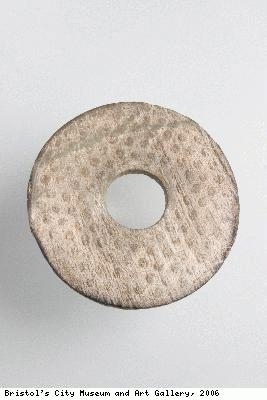
Description:
In ancient China wealthy people were sometimes buried with ritual discs like this (bi in Chinese) symbolising Heaven. The most precious bi discs were made of white jade. This one is made of white glass, which was easier to work and less expensive. The carved design of sprouting grain seeds symbolises rebirth and new life.
Glass, carved in relief
Width: 10.7 cm, diameter: 0.7 cm
Chinese Description:
墓葬圆壁 中国,约公元前 400-100,战国时代 (约公元前481-221)或 西汉朝(公元前206-12) 圆壁是祭天的礼器。富人或将礼器作随葬明器用,并以白玉做成最珍贵的圆壁。这件玻璃所制成的明器,较玉器更易碾琢,价值亦较平宜。其以穀芽纹装饰,更寓意重生。 玻璃,浮雕Creator: Unknown
Date: 400-100 BC
Copyright: Bristol Museums, Galleries & Archives
Object ID:N4813
Eye bead
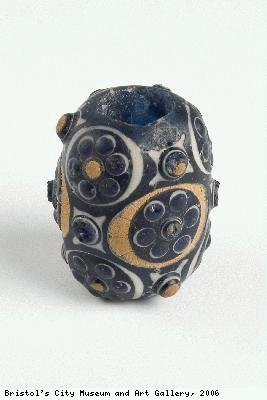
Description:
During the Warring States Period (481-221 BC) beautiful beads like this were made in China. They have been called “eye beads” because their rings of inlaid colours often stick out from the surface, and look like eyes.
Chinese glassmakers were inspired by imports of Roman beads traded along the Silk Route. They made the beads by dropping and trailing coloured glass onto the surface whilst heating with a flame to melt the colours into each other.
Glass, inlaid
Length: 2.8 cm, diameter: 2.3 cm
Chinese Description:
蜻蜓眼 中国,战国时代,约公元前 400-200 中国早在战国时代(公元前481-221)已制作出这类漂亮的玻璃珠子。不同颜色的圈纹与圆点形成瞳孔似的纹饰,故又称为「蜻蜓眼」。其风格与自丝绸之路入口的罗马珠子甚为相像,中国工匠或许由此取得创作灵感。。 玻璃,镶嵌Creator: Unknown
Date: Probably 400-200 BC
Copyright: Bristol Museums, Galleries & Archives
Object ID:N7847
Iranian flask
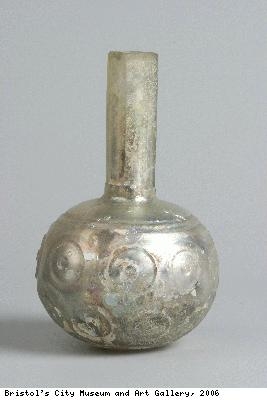
Description:
This flask was found in a burial site near Xi’an in central China but comes from Iran. The burial took place during the Tang Dynasty (618-907 A.D.) when Xi’an was a large and bustling city at the east end of the Silk Route. Merchants traded glass items like this along the route from Iran. Chinese people at the time placed a high value on these precious imported goods from the west.
Glass, degraded by burial, wheel-cut
Height: 16.5 cm, diameter: 10.0 cm, neck diameter: 2.8 cm
Chinese Description:
伊斯兰式扁瓶 大约来自伊拉克,公元800-900 此扁瓶出土于中国西安附近的墓葬遗址。该遗址可追溯至唐代(公元618-907年) ,当时西安座落于丝绸之路东端,是商业繁盛的大都会。这西来商货被当时中国人视为珍品。 玻璃,轮刻,日久侵蚀Creator: Unknown
Date: 800-900
Copyright: Bristol Museums, Galleries & Archives
Object ID:Or1984.11.01
Vase in the shape of ancient bronze wine beakers called gu
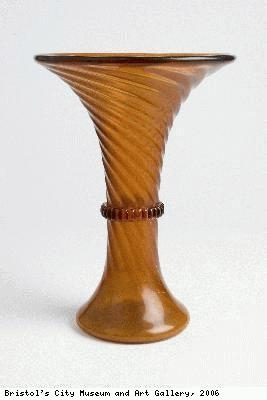
Description:
This vase copies the shape of ancient bronze wine beakers called gu. It may be very similar to the four amber glass gu beakers mentioned in the 1776 inventory of the Qianlong emperor’s retirement compound (Changchun Yuan) in the Summer Palace in Beijing.
Glass, blown and marvered
Height: 22.0 cm, diameter: 15.6 cm
Chinese Description:
玻璃觚 中国,清朝,约1800-1900 这玻璃瓶取材于古代青铜酒器—觚的设计。1776年(乾隆41年),工匠仿照青铜觚的式样,制成四件琥珀色玻璃觚,以供皇室园林长春园所用。这玻璃觚与上述描写相近,或许是当年其中一件器皿。 玻璃,吹制、熔合Creator: Unknown
Date: 1700-1800, Qing dynasty
Copyright: Bristol Museums, Galleries & Archives
Object ID:N4620
Vase in the shape of a gourd
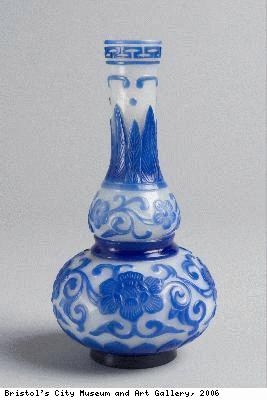
Description:
On the base of this vase is a six-character mark of the Qianlong emperor and the Chinese character for Heaven, tian. One of the names for an emperor in China was ‘Son of Heaven’ as people believed that emperors ruled the world on behalf of Heaven. This shows a close relationship with the imperial palace workshops.
The blue layer of glass is carved in a pattern copying imperial porcelain of the Ming dynasty (1368-1644). Throughout the Qing dynasty (1644-1911) educated people admired the shapes and designs of Ming ceramics and copies of Ming ceramics were popular in the imperial palace.
Glass, carved overlay
Height: 11.0 cm, diameter: 5.7 cm, neck diameter: 1.9 cm
Six-character mark of Qianlong (1736-1795) with character tian.
Chinese Description:
玻璃葫芦瓶 中国,清乾隆朝(1736-1795) 这只葫芦瓶的底部刻有「大清乾隆年制」及「天」字。古代皇帝又称为「天子」,意谓皇帝乃上天派来管治人间的代理人,显见玻璃制作与清廷的密切关系。 刻有「大清乾隆年制」及「天」字 玻璃,套料雕刻Creator: Unknown
Date: Qianlong reign period (1736-1795)
Copyright: Bristol Museums, Galleries & Archives
Object ID:N4554
Vase, green glass 1870-1930
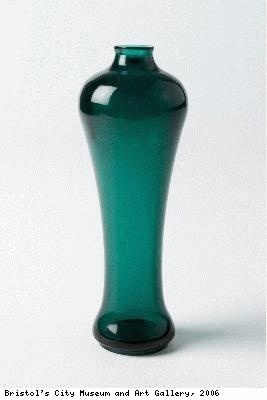
Description:
This vase has a similar shape to ceramic vases called meiping which were first made to hold branches of plum blossom. It has a narrow mouth and short neck with broad shoulders that curve down to the base.
Glass
Height: 11.8 cm, diameter: 4.2 cm, neck diameter: 1.5 cm
Chinese Description:
花瓶 中国,清朝或中华民国时期,约1870-1930 这玻璃瓶的形制相类于瓷器的梅瓶。梅瓶的瓶口细小,瓶颈短,瓶肩丰满,其至瓶底形成优雅的曲线。 玻璃Creator: Unknown
Date: 1870-1930, Qing dynasty
Copyright: Bristol Museums, Galleries & Archives
Object ID:N4598

